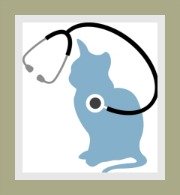Feline Leukemia
Treatment and Prevention
In order to treat feline leukemia (FeLV), a diagnosis needs to be confirmed.
We provide an indepth review on the diagnosis, treatment and prevention of this deadly disease in cats.
diagnosis of cat leukemia
The responsibility of the cat owner is to identify any signs or symptoms that may indicate that your cat is ill and then seek the expert advice of a veterinary practitioner.
As FeLV symptoms are
non-specific and may be indicative of a wide range of cat illnesses,
only the veterinary team will be able to confirm the nature of the
illness.
Your vet is likely to do the following:
-
Take a medical history from
the cat owner. (It's important to provide accurate details of the signs
and symptoms to assist the vet with the diagnosis).
- A full physical examination of the cat will include palpation of the abdomen, oral, aural and eye examinations.
- Blood, stool (feces) and saliva samples will be
taken from the cat and undergo microscopic cat leukemia tests.
- If the test is positive for FeLV, the veterinary practitioner will send the
samples away for further tests at an approved pathology laboratory.
- The
reason for this is that 'in-surgery tests' may give a false-positive
result.
- Laboratory tests will isolate any virus present and confirm the disease. In some cases the test may repeated in a couple of months to re-affirm the results.
- Whilst awaiting results, the veterinarian will advise you to isolate your cat from other cats and keep kitty indoors.
- Once the final results are received, symptomatic treatment will commence
Just a note regarding a positive diagnosis. A positive result should not be seen as a death sentence!
It does not always indicate that your cat is gravely ill or that it is permanently infected.
In some instances, it may only indicate that your kitty has just contracted the FeLV virus, he could be fighting off the virus and may have a good prognosis.
Your vet will advise you on the best course of action.
cat leukemia treatment
Keep in mind that there is no cure for cat leukemia i.e. FeLV.
All treatment is given in an effort to make the cat more comfortable and improve the cat's quality of life.
The treatment given will be symptomatic treatment (i.e. the vet will treat the secondary diseases or infections caused by the virus).
Treatment will be determined by the veterinary practitioner and we provide some examples of possible treatments that may be undertaken:
-
Chronic infections could be treated with local or systemic antibiotics
- Diarrhea and vomiting may be treated with anti-emetics and anti-diarrhea medication
- Analgesics or anti-inflammatory drugs for pain
- Rehydration therapy to treat dehydration
- Conjunctivitis and gingivitis may be treated with topical antibiotics
- Cancers may be treated with chemotherapy
- Home treatment will include isolation from other cats to avoid disease spread.
- Good nutrition and lots of TLC.
The vet may also recommend the testing of all other cats in the household.
Sadly, longterm treatment will be expensive and may buy the cat a little time.
In most instances, the cat will succumb to feline leukemia-related infections in a few months.
You may decide that euthanasia is a more humane option if your kitty is not responding to treatment. Quality of life should be a priority.
prevention of FeLV
cat leukemia vaccines
Prevention is better than cure!
There are several FeLV vaccines available. Your veterinary practitioner will be in the best position to provide you with information and recommend the most suitable vaccine for your cat.
Cat owners do need to be aware that whilst these feline vaccines provide some protection, they are not 100 percent effective. But they are the best option.
Generally the vet will first test the cat to ensure that it is FeLV negative. It would be fruitless (yet harmless) vaccinating a cat that is FeLV positive.
If negative the vaccine will generally be given in 2 doses approximately two to three weeks apart. Annual boosters of the vaccination are recommended.
The FeLV vaccine is not a mandatory feline vaccine. Cat owners can request that the FeLV vaccination be given at 9 weeks when the kitten receives its first routine vaccinations.
Your cat or kitten may be a little off-color for a day or two after vaccination.
In rare cases a tumor may develop at the site of the injection. More often the injection site will be sensitive and a little lump will develop at the injection site, but this generally disappears after a few days.
Feline vaccines and in particular the FeLV vaccine is recommended in the following conditions:
- Outdoor cats
- Cats that live in multi-cat households
- Cats that live in a densely populated environment
Vaccines are essential. Not only will they provide your cat
with some form of protection, it will limit the spread of feline
leukemia to other cats in the household or neighborhood.
general preventative measures
The best way to prevent feline leukemia is to vaccinate and most importantly to avoid exposure to the disease.
- Keep cats indoors. If the cat prefers the outdoors, ensure they have an escape-proof safe garden
- Neuter (spay or castrate) female and male cats to
decrease the desire to roam the neighborhood; it also reduces the
chances of cat fights.
- Test for feline leukemia in multi-cat households and separate cats that are positive from those that are negative.
- Keep your cat in good health by giving them the best
cat food, regular grooming, keeping vaccines up to date and maintaining
excellent hygiene.
- If at all possible, dissuade cats from sharing cat litter boxes, food and water bowls.
- If your cat has tested positive, do not breed with them and minimize contact with healthy cats.
- Detect any sign of cat illnesses early on and seek veterinary advice.
Return to Feline Leukemia Symptoms
search our site
please like us
share our site
recommend on google
favorite pages





